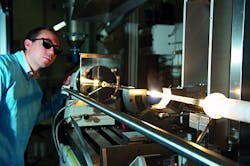University of Southampton to head $15M national Photonics Manufacturing Hub
The University of Southampton (England) will lead one of two $15 million (£10 million) research centers that will transform the UK’s manufacturing industries through the use of photonics.
The Engineering and Physical Sciences Research Council (EPSRC) National Hub in High Value Photonic Manufacturing was announced by Universities and Science Minister Jo Johnson. The second Hub in Future Liquid Metal Engineering is based at Brunel University (London).
Bringing together the expertise of Southampton’s Optoelectronics Research Centre (ORC) and the ESPRC National III-V Centre at the University of Sheffield, the Future Photonics Hub will provide national leadership in manufacturing for the next generation of photonics technologies. With more than 40 companies providing guidance and resources, the new Hub is solidly focused on improving UK manufacturing efficiency.
The Future Photonics Hub, which will be funded for seven years, will accelerate growth of the UK’s $15 billion (£10 billion) photonics industry and support the $900 billion (£600 billion) of UK manufacturing output that depends on photonics by:
- Improving existing manufacturing processes for production of photonics components;
- Supplying prototypes and subsystems to their designs; and
- Being a one-stop-shop for trialing user ideas and developing new manufacturing processes.
The primary economic impact of the Hub will be to aid rapid commercialization of emerging technologies. This will result in new products and services in both the photonics industry and in the industries enabled by photonics. Supporting companies across the UK have so far promised a total of $18.8 million (£12.5 million) in markets that include defense and security, communications, space, semiconductor manufacturing, and healthcare.
The investment in the Future Photonics Hub by EPSRC will be further enhanced by $4.5 million (£3 million) from the two universities.
Over five decades, the ORC has maintained a position at the forefront of photonics research. Its long and well-established track record in optical fiber, lasers, waveguides, devices, and optoelectronic materials has fostered innovation, enterprise, and cross-boundary and multi-disciplinary activities.
The ORC has built strong links with industry, research institutions, and universities around the world, from informal collaborations to large-scale funding. In 2014, it launched The Photonics Institute with Nanyang Technological University (NTU) in Singapore. Ten spin-out companies, including Fibercore, Fianium, SENSA, SPI Lasers, and Stratophase, have commercialized ORC research, while its extensive outreach program has brought lasers and optical fibers into schools across the country.
For more information, please visit www.southampton.ac.uk.
